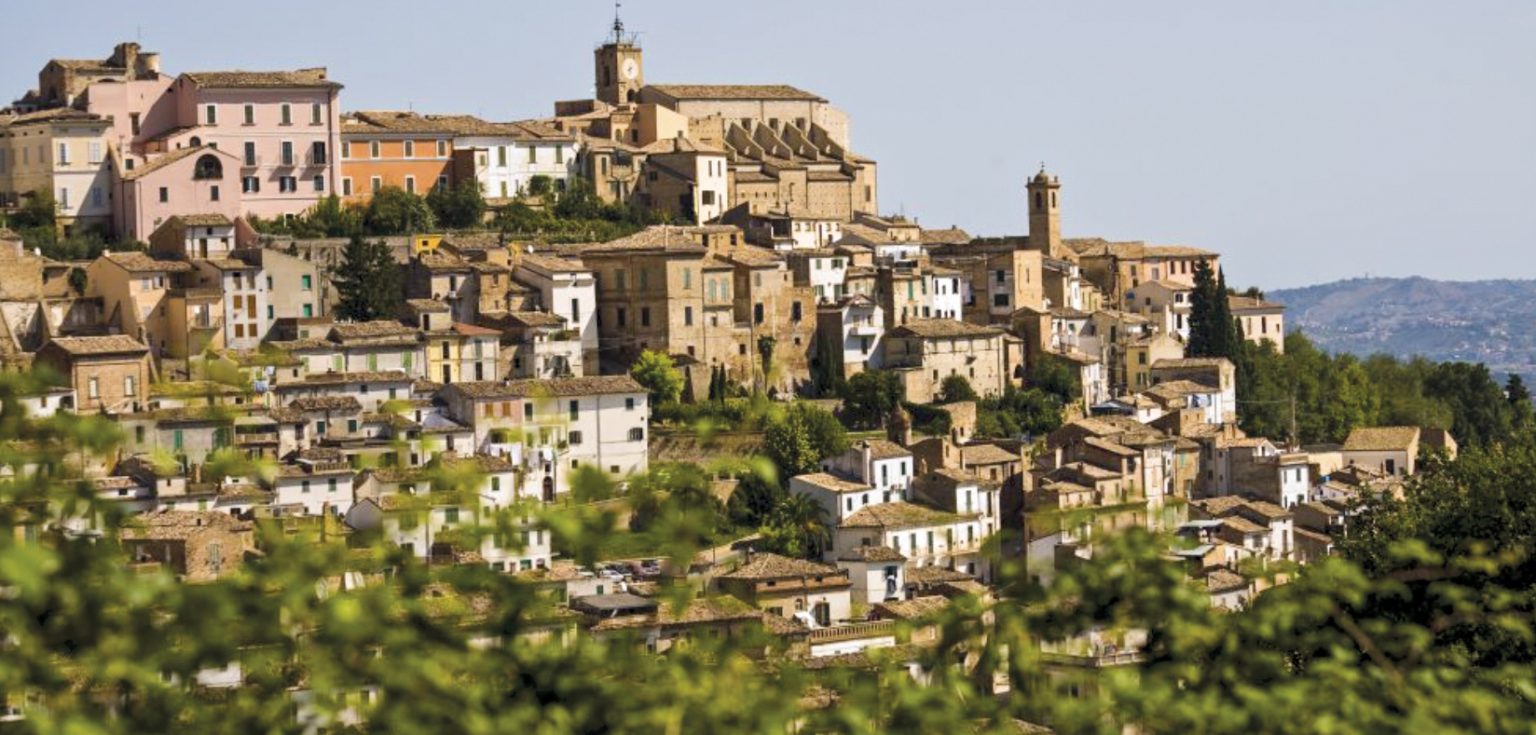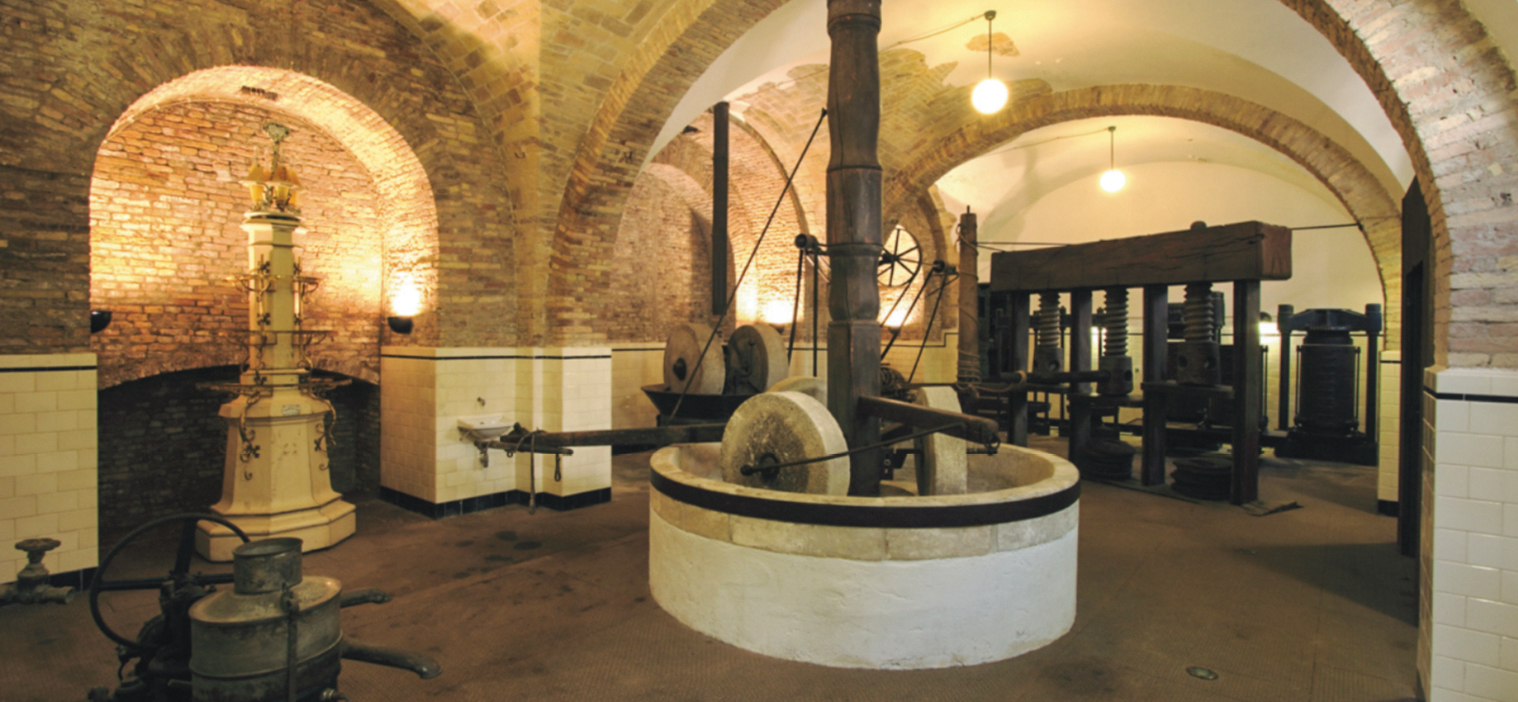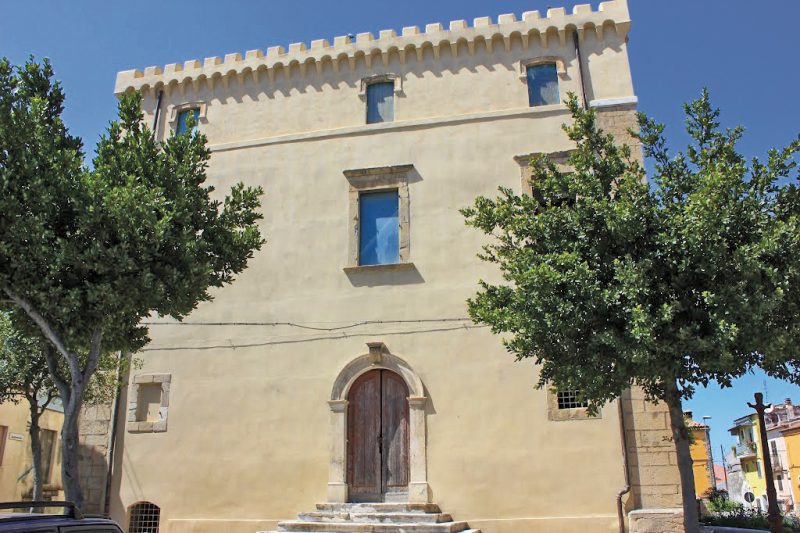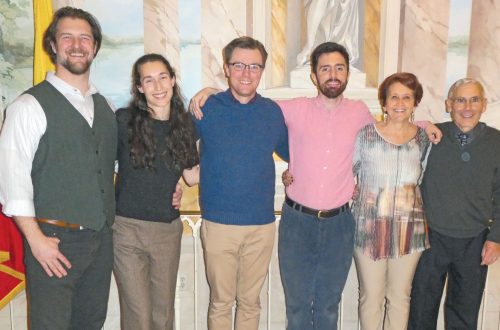-
Loreto Aprutino

By Nancy DeSanti
Province of Pescara, Region of Abruzzo
The picturesque town of Loreto Aprutino is located southwest of Pescara among hills of olive trees. It has approximately 7,549 inhabitants, known as Loretesi, and it is renowned for its world-class olive oil. Loreto Aprutino along with Moscufo and Pianella forms the so-called “golden triangle of olive oil.”
The town is built on a hillside, with its castle and the Church of San Pietro at the top of the hill. From there, visitors can see beautiful views over the golden stone houses with pale terracotta roofs below and the beautiful surrounding countryside, much of which is covered in ancient olive trees.

Panoramic view of Loreto Aprutino.
Credit: italythisway.comThe picturesque town of Loreto Aprutino is located southwest of Pescara among hills of olive trees. It has approximately 7,549 inhabitants, known as Loretesi, and it is renowned for its world-class olive oil. Loreto Aprutino along with Moscufo and Pianella forms the so-called “golden triangle of olive oil.”
The town is built on a hillside, with its castle and the Church of San Pietro at the top of the hill. From there, visitors can see beautiful views over the golden stone houses with pale terracotta roofs below and the beautiful surrounding countryside, much of which is covered in ancient olive trees.
Loreto Aprutino stands out against the sky with its imposing Palazzo Chiola (formerly a medieval castle) and the Church and the belltower of San Pietro Apostolo, promising the visitor a wealth of artistic and historical treasures.
A nearby Italic necropolis shows that the area was already inhabited in the 6th century B.C. This suggests that a significant pre-Roman settlement once existed near the modern town. Later on, in the early Middle Ages, it was known as Castrum Laureti because of the many bay laurels (laurus in Latin) that then grew in the area. Its importance in the medieval period is reflected in the many works of art which embellished the rich medieval center. Still later, it belonged to the D’Aquino family and in the 16th century was first under the D’Avalos and finally the D’Afflitto.
The town was built around a castle and abbey established by Benedictine monks around the year 1000 and rose to political prominence in the 11th century with the coming of the Normans. The town would be a stronghold of Swabian and Angevin nobility until the 14th century, when a series of important families would rule the town and the surrounding countryside up to the abolition of feudalism.
A nearby Italic necropolis shows that the area was already inhabited in the 6th century B.C.
In 1863, after the unification of Italy, the adjective “Aprutino” was added to the name of the town to distinguish it from several other towns with the same name — in Ancona province, in Asti province, in Novara province, and two separate towns in Perugia province. During this period, the town would experience a renaissance of culture and civic life after a long period of stagnation. The arts and crafts were supported by wealthy benefactors such as Giacomo Acerbo, who created the Museum of Ceramics. It was during this period that Castello Chiola, which dominates the skyline of the town, was constructed.
Castello Chiola was built on the site of a medieval castle which, according to the earliest records dates back to the 9th century, and at times was also used as a prison and military fort. Another significant landmark is the church of San Pietro Apostolo. Built in the 11th century, the church has a central nave and two aisles decorated with scrolls and baroque decorations, and side chapels with frescoes and tiled floors, the most important dedicated to St. Thomas Aquinas and St. Zopito the Martyr, the patron saint of the town.
Just outside the town is the church of S. Maria in Piano, which dates from 1280. On all the walls and ceilings are eight frescoes dating from the 14th to the 16th century, depicting stories of saints, including St. Thomas Aquinas, whose family commissioned the frescoes. But the more famous painting is the Giudizio particolare delle anime (“Unusual punishment of souls”), made with the technique by which colors are dissolved into melted wax and heated at the time of painting. The work represents the Divine Judgment as a difficult passage across a bridge as thin as a human hair (“The bridge of hair”), that only holy souls can overcome without falling into the river of boiling pitch, and who are then adorned with fine clothes and ascend to the heavens.
To learn more about the traditions of olive oil production, which in this area date back to the 4th century B.C., visitors can go to the olive oil museum. This museum happens to be housed in one of the most interesting buildings in Loreto Aprutino — a lovely stone Gothic building with a hexagonal tower at one end. The building was a former olive oil mill and was built in the 19th century. Its owner was a pioneer in the methods of quality olive oil production including the need to press the olives right away after harvesting. In the museum, visitors can see the olive presses and mill stones that were used in the oil production and learn about traditional methods of production.
Each spring on the first Monday after Pentecost, the town celebrates the Festa di San Zopito and a parade is held. A child, dressed all in white and wearing a crown of flowers, rides a white ox that is decorated with colored ribbons on its horns and a red mantle bearing an image of San Zopito. The child kneels down before the patron saint’s statue, and then follows it into the church.
Important Dates
- Monday after Pentecost — Feast of San Zopito, the patron saint
What to See
- Majestic Palazzo Chiola, from the 18th century
- Beautiful palaces and mansions including Palazzo Acerbo, Casa Antimo, Casa Baldini-Palladini and Casa Raietta
- The church of San Pietro Apostolo, with a silver urn with San Zopito’s relics
- The church of San Francesco d’Assisi, from the 14th century, with a beautiful portal and huge belltower, which was renovated in 1601
- The church of Santa Maria in Piano, with frescoes on the life of St. Thomas Aquinas, whose family ruled over the town, and the magnificent Universal Judgement Cycle
- The Torre Dragone remains
- The Museo Acerbo, with a fine gallery of Abruzzese ceramics.
Italiano

Tradotto da Ennio Di Tullio
Provincia di Pescara, Regione Abruzzo
La pittoresca cittadina di Loreto Aprutino si trova a sud-ovest di Pescara tra colline di ulivi. Conta circa 7.549 abitanti, conosciuti come Loretesi, ed è rinomata per il suo olio d’oliva di prima classe. Loreto Aprutino insieme a Moscufo e Pianella forma il cosiddetto “triangolo d’oro dell’olio d’oliva”.
Il paese è costruito su una collina, con il suo castello e la Chiesa di San Pietro in cima alla collina. Da lì, i visitatori possono vedere splendide viste oltre le case in pietra dorata con i tetti in terracotta chiara sottostanti e sulla bellissima campagna circostante, in gran parte ricoperta di ulivi secolari.

Equipment on display at the olive oil museum.
Credit: Fondazione Dei Musei Civici Di Loreto AprutinoLoreto Aprutino si staglia nel cielo con il suo imponente Palazzo Chiola (già castello medievale) e la Chiesa e il campanile di San Pietro Apostolo, e promette al visitatore una ricchezza di tesori artistici e storici.
Una vicina necropoli italica mostra che l’area era già abitata nel VI secolo a.C. Ciò suggerisce che un tempo esisteva un significativo insediamento preromano vicino alla città moderna. Successivamente, nell’alto medioevo, fu chiamato Castrum Laureti per via dei numerosi allori (laurus in latino) che crescevano nella zona. La sua importanza nel periodo medievale si riflette nelle numerose opere d’arte che abbellirono il ricco centro medievale. Ancora più tardi appartenne alla famiglia D’Aquino e nel XVI secolo passò prima ai D’Avalos e infine ai D’Afflitto.
Il paese sorse intorno ad un castello e ad un’abbazia fondata dai monaci benedettini intorno all’anno 1000 e assurse alla ribalta politica nell’XI secolo con l’avvento dei Normanni. Il paese sarà una roccaforte della nobiltà sveva e angioina fino al XIV secolo, quando una serie di importanti famiglie governeranno il paese e il contado circostante fino all’abolizione della feudalità.
Nel 1863, dopo l’Unità d’Italia, al nome del paese fu aggiunto l’aggettivo “Aprutino” per distinguerlo da diversi altri centri omonimi – in provincia di Ancona, in provincia di Asti, in provincia di Novara, e due distinti comuni della provincia di Perugia. In questo periodo la cittadina conoscerà una rinascita della cultura e della vita civile dopo un lungo periodo di stagnazione. Le arti e i mestieri furono sostenuti da ricchi benefattori come Giacomo Acerbo, che creò il Museo della Ceramica. Fu in questo periodo che venne costruito il Castello Chiola, che domina lo skyline della città.
Una vicina necropoli italica mostra che l’area era già abitata nel VI secolo a.C.
Il Castello Chiola è sorto sul sito di un castello medievale che, secondo le prime notizie, risale al IX secolo, ed a volte veniva utilizzato anche come prigione e forte militare. Un altro punto di riferimento significativo è la chiesa di San Pietro Apostolo. Costruita nell’XI secolo, la chiesa è a tre navate con volute e decorazioni barocche, e cappelle laterali con affreschi e pavimento in cotto, le più importanti dedicate a San Tommaso d’Aquino e San Zopito martire, patrono della città.
Appena fuori dal paese si trova la chiesa di S. Maria in Piano, che risale al 1280. Su tutte le pareti e sui soffitti ci sono otto affreschi databili dal XIV al XVI secolo, raffiguranti storie di santi, tra cui San Tommaso d’Aquino, la cui famiglia commissionò gli affreschi. Ma il dipinto più famoso è il “Giudizio particolare delle anime”, realizzato con la tecnica per cui i colori vengono sciolti in cera fusa e riscaldati al momento della pittura. L’opera rappresenta il Giudizio Divino come un difficile passaggio attraverso un ponte sottile come un capello umano (“Il ponte dei capelli”), che solo le anime sante possono superare senza cadere nel fiume di pece bollente, e che vengono poi adornate con bei vestiti e ascendono al cielo.
Per conoscere meglio le tradizioni della produzione dell’olio d’oliva, che in questa zona risalgono al IV secolo a.C., i visitatori possono visitare il museo dell’olio d’oliva. Questo museo si trova in uno degli edifici più interessanti di Loreto Aprutino, un delizioso edificio gotico in pietra con una torre esagonale a un’estremità. L’edificio era un ex frantoio ed è stato costruito nel XIX secolo. Il suo proprietario è stato un pioniere nei metodi di produzione dell’olio d’oliva di qualità, inclusa la necessità di spremere le olive subito dopo la raccolta. Nel museo i visitatori possono vedere i frantoi e le macine in pietra utilizzati nella produzione dell’olio e conoscere i metodi tradizionali di produzione.
Ogni primavera, il primo lunedì dopo Pentecoste, la città celebra la Festa di San Zopito e si tiene una sfilata. Un bambino, vestito tutto di bianco e con una corona di fiori, cavalca un bue bianco decorato con nastri colorati sulle corna e un manto rosso con l’immagine di San Zopito. Il bambino si inginocchia davanti alla statua del santo patrono, e poi la segue in chiesa.
Le attrazioni del luogo:
- Maestoso Palazzo Chiola, del XVIII secolo
- Splendidi palazzi e ville tra cui Palazzo Acerbo, Casa Antimo, Casa Baldini-Palladini e Casa Raietta
- La chiesa di San Pietro Apostolo, con un’urna d’argento con le reliquie di San Zopito
- La chiesa di San Francesco d’Assisi, del XIV secolo, con un bel portale e un enorme campanile, ristrutturata nel 1601
- La chiesa di Santa Maria in Piano, con affreschi sulla vita di San Tommaso d’Aquino, la cui famiglia regnava sul paese, e il magnifico Ciclo del Giudizio Universale
- I resti di Torre Dragone
- Il Museo Acerbo, con una bella galleria di ceramiche abruzzesi.
Date da ricordare:
- Lunedì dopo Pentecoste — Festa di San Zopito, patrono
Sources: en.wikipedia.org/wiki/Loreto_Aprutino
www.italyheritage.com/regions/abruzzo/pescara/loretoaprutino.htm
www.italythisway.com/places/loreto-aprutino.phpJanuary/February 2022
-
Petacciato

By Nancy DeSanti
Province of Campobasso, Region of Molise
The beautiful town of Petacciato is located in the province of Campobasso. It has approximately 3,488 inhabitants known as Petacciatesi. Although situated in a beautiful position on a green hill not far from the sea, it is threatened by unstable soil where a number of landslides have taken place in the last 50 years. It is one of the few centers in Molise that has seen population growth, thanks especially to the summer tourism in Petacciato Marina, with its fine beach with sand dunes and its coastal pinewood.
The town’s dominant position offers a unique and evocative panorama that extends the view from the Maiella mountains to the Gargano promontory, crossing the archipelago of the Tremiti Islands.
One of the sights worth seeing is the Church of San Rocco, which is Romanesque in origin and has a massive bell tower. It shares the town center with the exquisite Renaissance Palazzo Ducale Battiloro, another noteworthy sight.
The name Petacciato derives from the Latin “Civita potatius.” In 1274, the fiefdom belonged to Godeffroy de Meliac, and in 1421, it was brutally attacked by the forces of Corrado Lupo, leaving many victims. Attacked again by the Caldora in the 17th century, the town found finally some peace with the Duke of Celenza. Petacciato has been an independent municipality since 1923, while before it had been a frazione of Guglionesi.

The Palazzo Ducale Battiloro in Petacciato
Credit: molisecoast.comThe town still retains the signs of the presence of the Battiloro family with its Ducal Palace. Probably dating back to the Norman period, the palace is situated in the main square of the town, while the nearby Romanesque-style Church of Saint Mary dates back as far as the 11th century. Along the coast there are the ruins of a tower, probably built to protect against the danger of Turkish invasions. Its countryside, rich in vineyards and olive trees, descends to the sea, providing a beautiful landscape that is no doubt drawing the increasing number of summer tourists.
Important Dates
- August 16 — Feast of San Rocco, the patron saint
What to See
- The church of San Rocco from the 13th century
- The Renaissance Palazzo Ducale Battiloro
Italiano

Tradotto da Ennio Di Tullio
Provincia di Campobasso, Regione Molise
La bella cittadina di Petacciato si trova in provincia di Campobasso. Conta circa 3.488 abitanti detti Petacciatesi. Pur essendo situato in bella posizione su una verde collina poco distante dal mare, è minacciato da un terreno instabile dove negli ultimi 50 anni si sono verificate numerose frane. È uno dei pochi centri molisani che ha visto crescere la popolazione, grazie soprattutto al turismo estivo a Petacciato Marina, con la sua bella spiaggia con dune di sabbia e la sua pineta costiera.
La posizione dominante del paese offre un panorama unico e suggestivo che estende la vista dai monti della Maiella al promontorio del Gargano, attraversando l’arcipelago delle Isole Tremiti.
Uno dei luoghi da vedere è la Chiesa di San Rocco, di origine romanica, con un massiccio campanile. Condivide il centro del paese con il pregevole Palazzo Ducale Battiloro rinascimentale, altro spettacolo degno di nota.
Il nome Petacciato deriva dal latino “Civita potatius”. Nel 1274 il feudo appartenne a Godeffroy de Meliac, e nel 1421 fu assalito brutalmente dalle forze di Corrado Lupo, lasciando molte vittime. Attaccato nuovamente dai Caldora nel XVII secolo, il paese trovò finalmente pace con il duca di Celenza. Petacciato è comune autonomo dal 1923, mentre prima era frazione di Guglionesi.

The Palazzo Ducale Battiloro in Petacciato
Credit: molisecoast.comIl paese conserva ancora i segni della presenza della famiglia Battiloro con il suo Palazzo Ducale. Risalente probabilmente al periodo normanno, il palazzo è situato nella piazza principale del paese, mentre la vicina Chiesa di Santa Maria in stile romanico risale al XI secolo. Lungo la costa si trovano i ruderi di una torre, probabilmente costruita per proteggersi dal pericolo delle invasioni turche. Le sue campagne, ricche di vigneti e ulivi, scendono fino al mare, offrendo uno splendido paesaggio che sta sicuramente attirando il crescente numero di turisti estivi.
Le attrazioni del luogo:
- La chiesa di San Rocco del XIII secolo
- Il rinascimentale Palazzo Ducale Battiloro
Date da ricordare:
- 16 agosto — Festa di San Rocco, patrono
Sources: en.wikipedia.org/wiki/Petacciato
www.italyheritage.com/regions/molise/province-campobasso/petacciato.htm
molisecoast.com/en/petacciatoJanuary/February 2022
-
Siamo Una Famiglia

Welcome, Lillie
By Maria D’Andrea-Yothers
On October 14, 2021, Maria D’Andrea-Yothers and Sam Yothers welcomed their first grandchild, Lillie Jade Gardner, into the world. The delivery was safe and healthy. The proud grandparents, Nonna Maria & Pappy Bammer, got to meet Lillie over Thanksgiving, where they spent the holiday in Fletcher, N.C., with Lillie, her mom Mara and dad John, Lillie’s aunt Lauren, and three dogs. Needless to say, Lillie is one special little girl, and will be spoiled rotten when Maria and Sam retire and relocate near Fletcher (Asheville), N.C., on or around 2024.

Maria D’Andrea-Yothers and Sam Yothers doting on new granddaughter Lillie Jade Gardner. The Innate Courtesy of Our People
By Omero Sabatini, AMHS Past President
A little while ago, talking with a woman whom I had just met and whose name I did not know, I addressed her as lady. But then it occurred to me how rude that would have been in our part of Italy.
You see, over there when talking with a woman with whom one is not on familiar terms, one never addresses her simply as lady. It is always, always beautiful lady (or bella fe’ if using the local Abruzzese dialect). The same goes when talking with a man who is a stranger. It is always, always good sir (or bon’o’ in the local dialect), instead of simply sir.
As far as I know, the endearing terms beautiful and good are not used in circumstances like this in any other western country. So, dear beautiful ladies and dear good sirs, let us be worthy of our heritage, and always, always be courteous to one another.
AMHS Membership
Birthdays Compleanni a Gennaio
Michael Bishop, January 1; Carmela Ventresca, January 2; John Iazzetti, January 4; John Iademarco, January 5; Americo Allegrino, January 8; Abraham Avidor, January 12; Carla DiBlasio, January 17; Monica Palenski Reed, January 18; Peter DiGiovanni, January 19; Henry Lisciotti and Panela Pasquariello, January 21; Lena Lupica, January 22; Bess DiTullio and Karen Kiesner, January 24; Nonna Noto, January 26; Angela Puglisi, January 28; and Mariadina Di Gennaro, January 30.Compleanni a Febbraio
Roberto DiTullio, February 2; Rose Silvestri Canahl, February 5; Robert Baldassari, February 7; Carmen Ciccione, February 8; Louis Sacchetti, February 9; Stephan Carrier and Mark Lino, February 10; Joseph Breda, February 12; Julie Finigan-Dal Forno, February 14; William Sansalone, February 16; William Anthony Meaux, February 17; Elisa DiClemente and Andrea Balzano, February 18; Lana Nardella, Joseph DiBlasio, and Gerry McCluer, February 19; Francesco Isgro and Tom Sweeney, February 21; Gino Marinucci, February 22; Jana Monaco and Diana DelGrosso, February 23; Lourdes Tinajero, February 25; and Michele LaVerghetta and Caridad de la Vega, February 27.Anniversaries Anniversari a Gennaio
NoneAnniversari a Febbraio
Sam & Maria (D’Andrea) Yothers, February 11; Rocco & Yoni Caniglia, February 14; and Michael & Dena DeBonis, February 15.Membership Information Category # of Persons
Associate (Couple): 5 x 2 = 10
Associate (Individual): 41
General (Couple): 46 x 2 = 90
General (Individual): 92
Honorary: 11
Scholarship: 2
Student: 7
Total Membership: 253January/February 2022
-
Venice Expert Eric Denker to Speak at January Program
By Nancy DeSanti, 1st Vice President-Programs
We have a treat in store for AMHS members and guests who come to our first program of the new year, on January 30, 2022. Eric Denker, the highly regarded Senior Lecturer at the National Gallery of Art for many years, will give us a talk on Venice, to get us in the mood for that city’s famous Carnevale.
Since 1978, he has been with the National Gallery of Art, most recently as Senior Lecturer and Head of Tours and Lectures. Denker, who has a Ph.D. from the University of Virginia, studied in Bologna and speaks Italian.
Denker has long been a devoted fan of Venice. One of our members who attended his lecture on that city at the Smithsonian said it was like “being transported to Venice.” His publications include the 2003 exhibition catalogue “Whistler and His Circle in Venice” (at the Corcoran Gallery of Art in Washington) and an etiquette guide to the city, entitled “No Vulgar Hotel: The Desire and Pursuit of Venice,” co-written in 2007 with his friend Judith Martin, better known as “Miss Manners.”
His lectures have also included “Raphael and His Circle,” “Degas at the Opera,” “Tintoretto Central: La Scuola Grande di San Rocco” and “In the Wake of Whistler: Prints of Venice, 1900-1940.”
Denker would like to make his presentation in honor of recently deceased Holy Rosary parishioner Diego D’Ambrosio, who was well-known to many of our members.
Lunch will be served in Casa Italiana, and we invite our members and guests to plan to attend what is sure to be a very interesting and informative talk. Please check your email inbox for further details and registration information.

Eric Denker
Credit: National Gallery of ArtJanuary/February 2022









